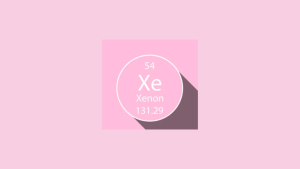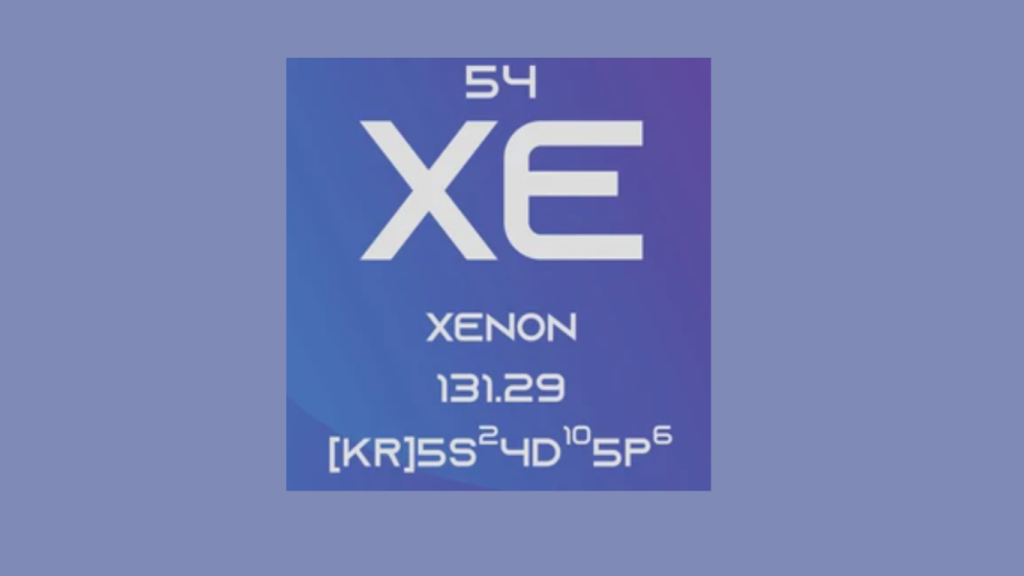The Xenon electron configuration can be expressed as [Kr] 4d^10 5s^2 5p^6. Xenon is a chemical element with atomic number 54, and it belongs to the noble gas family.
Xenon is a colorless, odorless gas with no significant chemical reactivity due to its completely filled outer shell. Its unique electron configuration makes it an important element in areas such as lighting, medical imaging, and anesthesia. We will explore Xenon’s electron configuration, properties, and applications in more detail.
What Is Xenon?
Xenon is a chemical element with the symbol Xe and atomic number 54. It is a colorless, dense, odorless noble gas present in the atmosphere. Although not abundant in the atmosphere, xenon is widely used in various applications. It is one of the least reactive noble gases and has several unusual properties that make it unique among the elements.
Overview
Xenon is a member of the noble gas family, also known as inert gas. It is located in group 18 of the periodic table and has a full valence electron shell, making it stable and unreactive. Xenon has nine stable isotopes, including the most abundant, 124Xe and 130Xe. It is produced by the slow decay of radioactive elements and is extracted from the air via liquefaction and separation methods.
Properties Of Xenon
| Property | Value |
|---|---|
| Atomic number | 54 |
| Atomic mass | 131.29 |
| Melting point | -111.7°C |
| Boiling point | -108.1°C |
| Density | 5.894 g/L |
| State at room temperature | Gas |
| Color | Colorless |
Xenon is a non-toxic and non-flammable gas with several unique properties, such as low reactivity, high ionization potential, and high electronegativity. It is used in various applications, such as lighting, medicine, nuclear energy, space technology, and research. Xenon is also known for its ability to produce a bright blue glow when energized, making it suitable for use in lamps and lighting fixtures.
- Xenon is used in medical imaging to produce clear images of internal organs and tissues.
- Xenon is used in nuclear reactors as a neutron absorber and coolant.
- Xenon is used in ion propulsion systems to propel spacecraft.
- Xenon is used in high-intensity arc lamps to produce bright and efficient light.
In conclusion, xenon is a rare and unique element with several important applications in various fields. Its unusual properties make it a valuable resource for researchers, scientists, and engineers.
What Is Electron Configuration?
Electrons in an atom are arranged in different energy levels or shells. The way these electrons are arranged in an atom is referred to as electron configuration. It is the distribution of electrons of an atom or a molecule in its atomic or molecular orbitals. The electrons of atoms are distributed so that the atom’s energy is at its minimum. The electron configuration of an atom describes the way electrons are distributed in the atom’s energy levels.
Definition
Electron configuration is the distribution of electrons in an atom or molecule’s atomic or molecular orbitals. It describes the arrangement of electrons in different energy levels or shells in an atom.
Importance
Electron configuration is an important concept in chemistry, as it helps to understand elements’ chemical and physical properties. It can determine how an atom will react with other atoms or molecules to form chemical bonds. The properties of an element are largely determined by the arrangement of electrons in its atoms. Electron configuration can help predict the behavior of elements in chemical reactions and their physical properties, such as melting and boiling points and magnetic properties.
An Example Of Xenon Electron Configuration
Xenon is a chemical element with the symbol Xe and atomic number 54. Its electron configuration is 1s22s22p63s23p63d104s24p64d105s25p6. This means that Xenon has eight electrons in its valence shell, making it a stable element with little tendency to react with other elements.
Understanding electron configuration is crucial for anyone studying chemistry or interested in the behavior of elements. It helps us to understand why some elements react with others to form compounds while others remain inert. Without electron configuration, we would not be able to explain the properties of different elements and how they interact with each other.
Xenon Electron Configuration
Xenon’s electron configuration is 2, 8, 18, 18, 8. This noble gas has a full outer shell, making it non-reactive and stable. Its unique electron configuration allows for various applications, such as in lighting and anesthesia.
Xenon is a member of Group 18 elements in the periodic table. It is a noble gas with atomic number 54 and the symbol Xe. Xenon has eight electrons in its outermost shell or valence shell. Its electron configuration plays an important role in its chemical and physical properties. In this article, we will dive deeper into the ground state and excited state configurations of xenon.
Ground State Configuration
The ground state electron configuration of xenon is 1s2 2s2 2p6 3s2 3p6 4s2 3d10 4p6. In simpler terms, it means that xenon has the electron configuration of [Kr] 4d10 5s2 5p6. The [Kr] represents the electron configuration of a krypton noble gas atom. The 4d10 5s2 5p6 part represents the electron configuration of the xenon atom. The noble gas configuration indicates that xenon is stable in its natural state and does not readily form compounds with other elements.
Excited State Configuration
When an electron is excited, it can move from a lower energy level to a higher energy level. Xenon can be excited to different energy levels, resulting in different excited state configurations. For example, when a xenon atom absorbs energy, its electrons can be excited to the 5d and 6s orbitals, resulting in the excited state configuration of [Kr] 4d10 5s2 5p5 5d1 6s1.
Explanation Of Configuration
In the ground state electron configuration of xenon, the valence shell is completely filled with eight electrons, making it stable and unreactive. The excited state electron configuration has a partially filled valence shell, giving the xenon atom more reactivity than its ground state. This partial filling of the valence shell makes the atom more susceptible to chemical reactions. In conclusion, understanding the electron configuration of xenon is crucial to comprehend how it behaves in different chemical reactions. The ground and excited state configurations are essential in determining noble gases like xenon’s chemical and physical properties.
How Is Xenon Used?
Xenon is a noble gas known for its unique chemical makeup and electron configuration. The electron configuration of Xenon has made it useful in various applications, including medical and lighting purposes.
Medical Applications
Xenon gas is used in medical imaging, specifically in X-ray and CT scans. It is also used as an anesthetic during surgical procedures. Researchers are also exploring the potential use of Xenon in neuroprotection, as studies have shown it may have protective effects on brain cells.

Lighting Applications
Xenon is used in lighting applications because it produces a bright, white light. It is used in high-intensity discharge lamps, which are commonly used in car headlights and studio lighting. Xenon lamps also have a long lifespan and high efficiency, making them a popular choice in commercial and industrial settings.
| Application | Benefits of Xenon |
|---|---|
| Medical Imaging | Clearer images, less radiation exposure |
| Anesthesia | Fast-acting and safe |
| High-intensity discharge lamps | Bright, efficient, and long-lasting |
- Xenon is a useful gas in medical and lighting applications due to its unique electron configuration.
- Medical applications include X-ray and CT imaging, anesthesia, and potential neuroprotection.
- Lighting applications include high-intensity discharge lamps used in car headlights and commercial settings.
- Xenon lamps have a long lifespan and high efficiency.
Overall, Xenon’s unique properties have made it a valuable resource in various industries. Xenon’s electron configuration has opened the door for innovative applications and technologies, from improving medical imaging to lighting up the night. Google maps
Frequently Asked Questions On Xenon Electron Configuration
Why Is The Electron Configuration Of Xenon 2 8 18 18 8?
Xenon’s electron configuration is 2 8 18 18 8 because it has 54 electrons distributed in five energy levels/shells. The first shell can accommodate 2 electrons, the second shell can accommodate 8, the third and fourth shells can hold 18 each, and the fifth shell can hold a maximum of 8 electrons.
What Is The Electron Configuration Of The Element 1s2 2s2 2p6 3s2 3p6 3d6 4s2?
The element’s electron configuration is 1s2 2s2 2p6 3s2 3p6 3d6 4s2.
What Is The Electrons Of Xe?
Xenon (Xe) has 54 electrons, with 6 electrons in its outermost shell.
What Is The Atomic Number Of 54?
Xenon has an atomic number of 54.
Conclusion
Understanding the electron configuration of xenon is crucial for those interested in chemistry. From the noble gases family, xenon is the heaviest, thus having more electrons. The electron configuration of xenon is relatively stable, making it useful in various applications, including lighting and anesthesia.
As we move forward, a better understanding of this element’s properties will lead to further technological advancements and potential discoveries.
